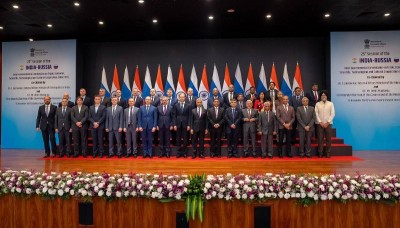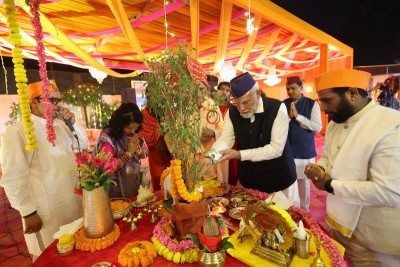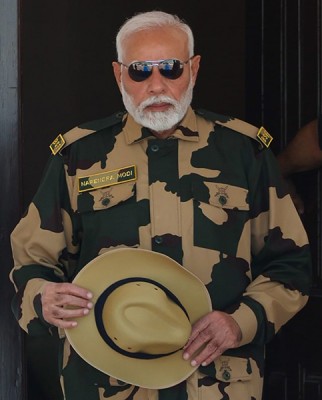
Jharkhand: Appearances and Reality
Earlier, on June 17, 2016, a Central Reserve Police Force (CRPF) trooper belonging to the Commando Battalion for Resolute Action (CoBRA) unit, identified as B. Harizen, was killed in an encounter with the Communist Party of India-Maoist (CPI-Maoist) in the forests of Patharchhapra under Pirtand Police Station limits in the Giridih District
On May 12, 2016, a Chatra-based journalist - Akhilesh Pratap Singh - was killed by Tritiya Prastuti Committee (TPC) cadres over a payment dispute in the Chatra District. The Jharkhand Police noted that Singh, a part-time contractor, was killed after he allegedly failed to pay a 'levy' to the TPC. TPC is another CPI-Maoist splinter
These killings continue amidst the political and bureaucratic rhetoric of finishing off Left-Wing Extremist (LWEs) groups in the first six months of the current political dispensation coming to power. There are around 19 LWE groups operating in the State, including CPI-Maoist, PLFI and TPC. After taking the oath as Jharkhand Chief Minister on December 28, 2014, Raghubar Das had declared, on January 15, 2015, that his Government would "rise to the challenge" posed by LWEs and "decimate extremism and CPI-Maoist violence in the State within six months". Going one step further, the then Chief Secretary of Jharkhand Sajal Chakrabarty, on January 14, 2015, boasted at a Press Conference in Ranchi that "In three months, there will be no active Naxal activity here. For me, the best Naxalite is a dead Naxalite."
According to the South Asia Terrorism Portal (SATP) database since the Raghubar Das Government came to power, 97 persons, including 27 civilians, 14 Security Force (SF) personnel and 56 LWEs have lost their lives in the State. Since 2005, 1,417 people, including 605 civilians, 319 SF personnel and 493 LWEs have been killed in Jharkhand (data till June 27, 2016)
In the first nearly six months of 2016 [data till June 26], 39 persons, including 11 civilians, nine SF personnel and 19 LWEs, have been killed in the State, as against 44 persons, including 12 civilians, two SF personnel and 30 LWEs killed in the corresponding period of 2015. The killing of a larger number of SF personnel in 2016, as against the figure for the same period in 2015, and fewer LWEs, should be worrying
An overview of fatalities over the last six years shows that, since 2011, Jharkhand has accounted for 224 LWE-linked fatalities, including 100 of the CPI-Maoist (43.25 per cent), and 16 PLFI cadres, two TPC cadres, one Jharkhand Sangharsh Jan Mukti Morcha (JSJMM) cadre. The combined percentage of PLFI, TPC and JSJMM cadres killed in Police encounters amounts to 9.82 per cent. 89 LWEs were killed in fratricidal fighting (39.26 per cent); 11 were lynched by the public; and five deaths resulted from accidental blasts.
Significantly, there is little difference (3.99 per cent) between the number of Maoists killed in encounters with SF personnel and fratricidal fights. In fact, larger numbers of LWEs were killed in fratricidal fights in 2012, 2013 and 2014, than in SF operations. Worse, despite knowing that various LWE groups other than CPI-Maoist also have a vice-like grip over much of the State, the Government has hardly gone after such groups. Just 19 PLFI, TPC and JSJMM cadres have been killed in the Jharkhand in the last six years. Further, dissection of the data suggests that, in 2016 alone, seven of the 11 civilians killed, fell to PLFI cadres, two to TPC, two to CPI-Maoist, and one civilian died in Maoist-PLFI cross fire.
Against this backdrop, the State Government's decision on June 18, 2016, to strike off several 'armed groups' from the official list of LWE organisations and declare them 'rogue groups' is questionable. Having to contain these groups as LWE actors, it is not clear how state Forces neutralize them under their new designation as criminal outfits. The delisting of these groups appears intended to bring down LWE-linked fatality numbers, but would fail to tackle the real issue. Significantly, this is not the first time such redefinitions have been attempted. On May 18, 2014, Jharkhand's then officiating Chief Secretary Sajal Chakraborty had declared that Jharkhand's LWE "threat (is) blown out of proportion" because criminal acts committed by Maoist splinter groups, without ideological moorings, simply inflated the number of violent incidents. It was said that only the CPI-Maoist will remain on the LWE list while splinter groups like Jharkhand Prastuti Committee (JPC), Sangharsh Janmukti Morcha (SJMM), Sashastra People's Morcha (SPM), Revolutionary Communist Centre (RCC), Jharkhand Janmukti Parishad (JJMP), PLFI and TPC may be dropped, though the proposal was not pursued at that stage.
Nevertheless, LWEs in Jharkhand do realise that the going is increasingly becoming tougher not just in the state but also in other theatres of conflict in India, including Chhattisgarh , the epicentre of Maoist violence.
The opening of two CRPF camps in the Saranda Forest - which had a dominant CPI-Maoist presence in 2009-11 - on June 20, 2016, just one kilometre from the Odisha border, will go a long way in preventing cross-border movement and strengthening anti-LWE operations. The camps in the Nuagaon and Tirilposhi areas of Saranda in the West Singhbhum District of Jharkhand will fill up the security 'vacuum' in vulnerable forest pockets used by LWEs to operate on both sides of the State border.
Media reports on June 18, 2016, indicated that, to augment their capability and effectiveness, the top Maoist leadership has sent one of its senior leaders, Sudhakaran, to Jharkhand from Andhra Pradesh, to rebuild the organization. A source in the State Intelligence Department disclosed that Sudhakaran had reached Jharkhand and was engaged in activities to revive the party and motivate armed cadres
On June 22, 2016, a media report claimed that officials of the National Investigation Agency (NIA), who were probing arms smuggling in India's North-eastern states, had come across evidence that the Maoists operating in Jharkhand had been supplied with sophisticated M-16 rifles. Sources indicated that the weapons were sourced from Nagaland and transported to the CPI-Maoist in Jharkhand by arms syndicates.
Despite the resolve of recent Jharkhand Governments to fight CPI-Maoist and other LWE formations - after years of ambivalence under predecessor regimes - the rebels have retained the strength and resilience to spread their influence in 21 of the 24 Districts across Jharkhand. Through 2015, SFs did make considerable inroads against these groups, but the problem is far from over and will demand hard operational strategies to overcome, not the fudging of data by redefining categories of LWE groups and activities.
Support Our Journalism
We cannot do without you.. your contribution supports unbiased journalism
IBNS is not driven by any ism- not wokeism, not racism, not skewed secularism, not hyper right-wing or left liberal ideals, nor by any hardline religious beliefs or hyper nationalism. We want to serve you good old objective news, as they are. We do not judge or preach. We let people decide for themselves. We only try to present factual and well-sourced news.







